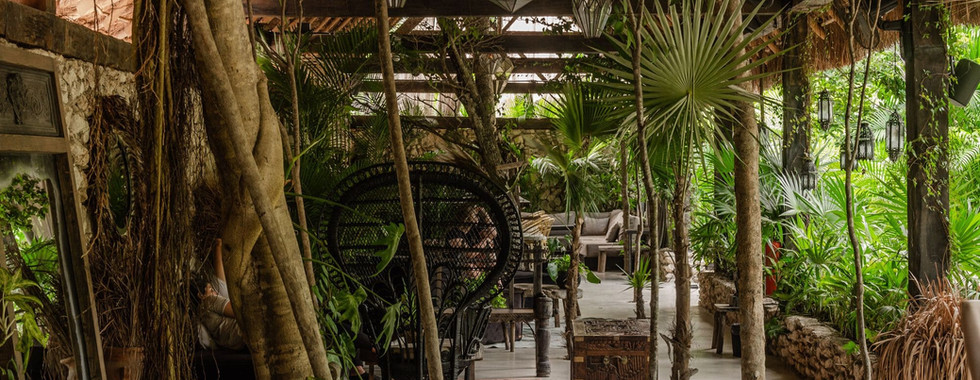Relax in the Bardo | Hotel Bardo by Taller de Arquitectura Viva
- Arq. Jenny Torres

- May 7
- 4 min read
Author: Jenny Torres
Passionate about the reinterpretation of the relationship between history and contemporaneity.
BUILDING: Hotel Bardo
ARCHITECTS: Taller de Arquitectura Viva
PHOTOGRAPHY: Leandro Bulzzano
LOCATION: Tulum, México
YEAR: 2020
M2: 2060 M2
White sand, archaeological landscapes, turquoise sea, good weather, different work and cultural opportunities; it looks like a perfect combination, doesn't it?
Tulum, located in the Yucatan Peninsula, is one of the main tourist attractions on the Caribbean coast, a paradisiacal destination amid Mayan ruins, tropical vegetation, entertainment, restaurants and hotels that arise in response to a growing demand for experiences, in this context the Hotel Bardo, designed by Taller de Arquitectura Viva, is characterized by the interest of the harmonious relationship between the vernacular and the contemporary.

The tourism and real estate boom that Tulum has experienced in the last ten years, through the growing redensification and transformation of the architecture of the capital Mexico City, is a wake coming from the potential that foreign and local investors have found in this paradise of virgin jungle, cenotes and unforgettable landscapes to offer vacation rentals with an ecological and sustainable look.
Counting with nearby points of interest and easy travel as Chichen Itza, Cancun and Playas del Carmen; has managed to attract with the help of visibility in social networks, more and more digital nomads, entrepreneurs and home offices eager to invest, who move to this oasis from where they can work and enjoy tourist attractions, renting hostels, Airbnb and resorts at lower cost; bets that have been beneficial for the economic estimation of Tulum.
However, latent concerns such as the lack of tourism regulation by the authorities, the gradual displacement of the inhabitants due to the increase in the value of the land, the privatization of its beaches, the damage to the flora and fauna caused by buildings that are not very sensitive to the context, result in disapproval by those who live there. That is why proposals such as the one made for the Bardo Hotel are so important.

A context-sensitive project that explores and implements an avant-garde design that balances luxury with boho chic style, an ecological vision that respects the environment, and employment opportunities for the residents of the sector.
Upon entering the hotel, it is perceived as a large courtyard, where vegetation is present to a greater extent compared to the built spaces, an aspect that was a decision from the design and is glimpsed by respecting the location of trees in the middle of social spaces, reaching all corners and spaces in multiple shapes and sizes.
The common areas totally open and turned towards the pool welcome you to the hotel; where you can get a complete view of the space from any point since the reception, bar, restaurant, rest area and yoga space converge to this central point where the boundary between inside and outside is blurred; being this an open sky extension of its surrounding spaces, providing an ideal flexibility for activities together, meet new people or activities provided by the hotel.
This flexibility, taken with the implementation of the “boho chic” [1] style in the design, allows the architects to create a fusion of cultures and eras that is perfect for Tulum, as well as giving the freedom to mix styles, combining them in a more subtle and orderly way. This can be found in the enclosures for the rooms in wood and in the choice of materials such as stone, wood and sand, which evoke the context in which it is implanted.
As for the interior design, neutral colors are used mainly on surfaces where natural light can enhance the walls and floors, being the perfect backdrop to highlight complements, therefore the necessary furniture is used to ensure a comfortable habitability where its materiality respects and values the local traditions with the use of natural fibers, fabric and texture, making the native look in a more sophisticated and elegant way, bringing life to the space.

Following this same line of the autochthonous, reflecting the cultural richness of the context, related to the sustainable vision and local construction processes, we have the vernacular architecture; it is about being inspired by the knowledge of the past with the objective of designing in a more ecological and conscious way.
In the case of Bardo, we notice it in the wooden structure, the stone walls for the common areas where the sloping thatched roofs and the sand paths are intertwined with the vegetation that plays an important role in integrating the common spaces to the interior of the hotel, the rooms and their immediate context.
However, when it comes to the guest rooms and the privacy afforded to guests, we notice a change; both in the configuration of the space and the choice of materials. The rooms are further away from the common area and communicate with it through a central circulation, placing rooms on each side; these spaces are perceived as more isolated where the visual is restricted by the natural enclosure prioritizing the relationship with the sky.
As for the choice of materials, we integrate those that have the ability to be durable and low maintenance, such as concrete, in order to give the space a more contemporary style, with appropriate amenities for relaxation, consequently, each room is equipped with a jacuzzi, a hammock or a sofa outside; they also have a small living room space, a double bed, storage, a private bathroom and an open-air shower.

Providing a pleasant experience for visitors and development opportunities for local communities should not put at risk the balance with the flora and fauna of the place where they develop, so it is imperative to integrate this item from the outset to the architectural proposals that are raised in the future for Tulum; since vegetation not only acts as an integrating and landscaping element, but also provides endless possibilities and qualities for a design as we saw in the Hotel Bardo where comfort, privacy, ancestral knowledge and luxury are in line with sustainability.
Do you also want to visit this paradisiacal place?
We leave you the link so you can make a reservation: https://www.hotelbardo.mx/
Don't forget to tag us in your photos when you do!


































































Comments